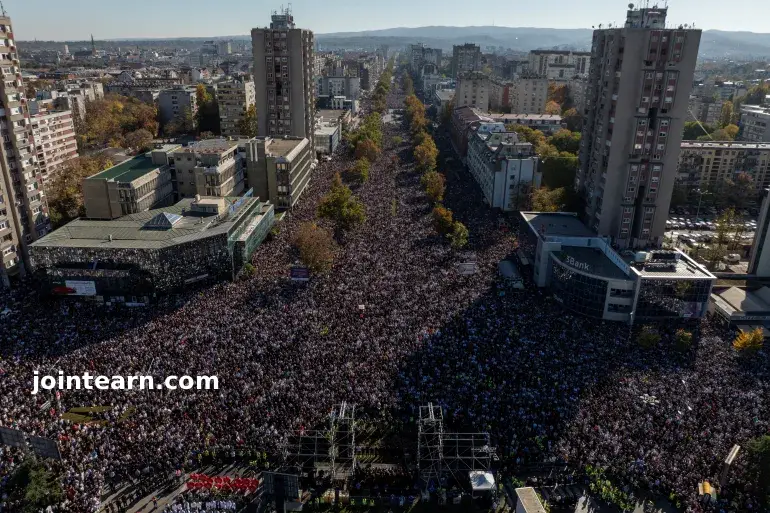As the Bihar Assembly election campaign intensifies, Rashtriya Janata Dal (RJD) leader Tejashwi Yadav took a sharp dig at Chief Minister Nitish Kumar and his party, the Janata Dal (United), alleging that the JDU is now effectively being run by three of its senior leaders — Lalan Singh, Sanjay Jha, and Vijay Choudhary — rather than by Nitish himself. The remark, made shortly after Tejashwi filed his nomination papers from Raghopur constituency in Vaishali district, sparked a fresh round of debate in Bihar’s politically charged environment where caste equations continue to play a pivotal role.
Tejashwi, who was accompanied by his parents and former Bihar chief ministers Lalu Prasad Yadav and Rabri Devi, used the occasion to position himself as the principal challenger to the ruling NDA, which includes the BJP and JDU. His attack on Nitish Kumar and his party was laced with both political and sociological undertones, highlighting the tensions within Bihar’s power structure and invoking the issue of caste dominance in the JDU’s leadership.
“Not Nitish Kumar’s Party Anymore”
Speaking to reporters after submitting his nomination, Tejashwi declared, “The JD(U) is not being run by Nitish Kumar, but by Lalan Singh, Sanjay Jha, and Vijay Choudhary.” He accused the three leaders of having “sold themselves to the BJP” and of “ruining Nitish Ji,” suggesting that the chief minister has lost control over his own party.
The statement drew attention to the political roles of the three figures he named. Lalan Singh, a Union Minister, currently serves as the national president of the JDU and is considered one of Nitish’s close confidants. Vijay Kumar Choudharyserves as a minister in the Bihar cabinet, while Sanjay Jha represents the JDU in the Rajya Sabha.
Tejashwi’s deliberate emphasis on their surnames — “Singh, Jha, Choudhary” — was more than rhetorical. It was a direct reference to the upper-caste dominance that he suggested has taken root within a party that historically drew strength from the Extremely Backward Classes (EBC) and Other Backward Classes (OBC). Nitish Kumar himself belongs to the Kurmi OBC community, and his political appeal has long rested on the image of an EBC-OBC-friendly leader who prioritized social justice and inclusive governance.
By stressing their surnames, Tejashwi sought to underline what he perceives as an ideological drift in the JDU — from a movement rooted in backward-class empowerment to one allegedly controlled by upper-caste elites aligned with the BJP’s agenda.
Nitish Kumar, the BJP, and the Question of Control
Nitish Kumar’s long political journey — marked by shifting alliances between the BJP, RJD, and other regional formations — has often been defined by his ability to balance power dynamics and maintain his stature as a secular yet pragmatic leader. However, recent developments have prompted speculation about his diminished autonomy within the NDA.
Tejashwi’s attack plays directly into that narrative. By naming key JDU figures and associating them with the BJP, he aimed to project Nitish as a weakened leader who has surrendered to political pressure. The claim that these leaders “have been sold to the BJP” reflects the opposition’s broader narrative — that the JDU has ceased to function as an independent political entity and has instead become a junior partner in the BJP-led alliance.
The political subtext of Tejashwi’s remarks also points to the RJD’s attempt to reassert itself as the primary voice of backward classes, Dalits, and minorities — groups that once formed Nitish Kumar’s core constituency.
The Symbolism of Raghopur: A Family Legacy
Tejashwi’s choice of Raghopur as his constituency carries deep symbolic significance. Known as the “fortress” of the Yadav family, Raghopur has been represented in the past by both his father Lalu Prasad Yadav and his mother Rabri Devi. The seat embodies the political heritage of the RJD and the family’s enduring influence over the region’s electorate.
The presence of both Lalu and Rabri during Tejashwi’s nomination filing underscored a public display of unity and generational continuity within the RJD. For supporters, it was an emotional reaffirmation of the party’s legacy; for opponents, a reminder of dynastic politics. But politically, it signaled that the RJD’s campaign will lean heavily on both nostalgia and change — a mix of invoking Lalu’s populism while projecting Tejashwi as a modern, development-oriented alternative.
Targeting the “Double Engine” Government
In his address, Tejashwi extended his attack beyond the JDU to the broader NDA government in Bihar, accusing it of corruption and failure on law and order. “One engine is engrossed in corruption, while the other is into crime,” he said, using the term “double-engine government” — a reference often used by the BJP to describe its rule in states where it governs both at the Centre and the state level.
The RJD leader claimed that the people of Bihar were disillusioned with the state’s direction and were “determined to bring about change.” He exuded confidence that the Mahagathbandhan (the Grand Alliance of RJD, Congress, and Left parties) would register a decisive victory, saying, “The people in Bihar want change, and change is destined to take place.”
Seat-Sharing Delays and Opposition Unity
Tejashwi’s nomination comes at a time when the Mahagathbandhan has yet to announce its final seat-sharing arrangement, sparking speculation about internal friction. However, RJD leaders have publicly dismissed concerns of discord.
Senior RJD spokesperson Mritunjay Tiwari, speaking to ANI, emphasized that “everything is fine in the Mahagathbandhan” and that the alliance remains united under Tejashwi’s leadership. He added, “There are no conflicts or conditions. The Mahagathbandhan is fighting strongly. With the people’s blessings, a Tejashwi government is going to be formed in Bihar.”
This confidence, however, masks the strategic complexity behind the scenes. While the RJD remains the dominant partner within the opposition bloc, negotiations with smaller allies over constituency allocations and campaign coordination are ongoing. The delay in formalizing seat-sharing could become a test of Tejashwi’s leadership and his ability to maintain cohesion within a diverse alliance.
The NDA’s Position
On the ruling side, the NDA — comprising the BJP, JDU, and other partners — is also in the process of finalizing its internal arrangements. Both the BJP and JDU have already released their first lists of candidates, with senior leaders like Deputy Chief Minister Vijay Kumar Sinha (who filed his nomination from Lakhisarai) and Deputy Chief Minister Samrat Choudhary (from Tarapur) contesting key seats.
The NDA’s campaign is expected to revolve around the themes of governance stability, infrastructure expansion, and welfare continuity. Yet, as Tejashwi’s comments indicate, the opposition intends to make caste representation, leadership control, and the alleged “BJP-isation” of the JDU central issues in its counter-narrative.
The Road to November
The Bihar Assembly election, scheduled for November 6 and November 11, with results to be declared on November 14, will be a decisive moment for both Tejashwi Yadav and Nitish Kumar. For Tejashwi, it represents an opportunity to transition from being the heir to the RJD legacy to establishing himself as a credible chief ministerial candidate in his own right. For Nitish, it may well be a battle to preserve not only his government but his political relevance in a state he has led for over two decades.
Tejashwi’s remarks about “Singh, Jha, and Choudhary” are more than an offhand jibe — they are an attempt to shape the narrative of Bihar’s election around who truly holds power and whose interests the ruling alliance represents. In a state where caste, loyalty, and leadership are deeply intertwined, such statements resonate beyond headlines, seeping into the local psyche of voters who see identity and governance as inseparable.
As Bihar gears up for another fiercely contested election, the clash between Tejashwi Yadav’s generational populismand Nitish Kumar’s seasoned pragmatism may define not only the outcome of 2025 but also the future trajectory of Bihar’s politics in the years ahead.


Leave a Reply